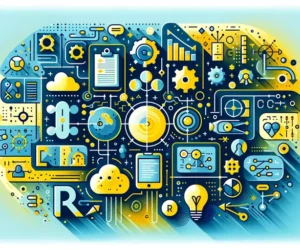
The Role of Generative AI in Machine Learning: An Integral Component

Generative AI is transforming the field of Machine Learning (ML) by enabling the creation of new content and data through advanced algorithms. Unlike traditional ML models that focus on classification and prediction, generative models are designed to generate data that mimics real-world distributions. This article delves into the pivotal role of generative AI in ML, exploring its applications, advantages, and challenges across various domains.
Understanding Generative AI: A New Paradigm
Definition and Core Concepts
Generative AI refers to a subset of ML models that generate new data samples from the underlying distribution of a dataset. These models learn the patterns and structures within the data and use this knowledge to create new, similar instances. Key generative models include Generative Adversarial Networks (GANs), Variational Autoencoders (VAEs), and autoregressive models.
GANs consist of two neural networks, a generator and a discriminator, that compete against each other. The generator creates fake data samples, while the discriminator evaluates their authenticity. This adversarial process continues until the generator produces highly realistic data. VAEs, on the other hand, use probabilistic approaches to encode data into a latent space and then decode it back to the original data space, generating new samples in the process.
Applications of Generative AI
Generative AI has a wide range of applications across different fields. In the entertainment industry, it is used to create realistic images, music, and videos. For example, GANs can generate lifelike images of non-existent people, while AI composers can create original music pieces. In healthcare, generative models assist in drug discovery by simulating molecular structures and predicting their properties.
BERT Machine Learning Model Reshaping NLPIn the field of natural language processing (NLP), generative AI powers chatbots and virtual assistants by generating human-like responses. Additionally, it is used in text completion and translation services. The ability of generative AI to produce high-quality, diverse data makes it invaluable in data augmentation for training robust ML models.
Advantages of Generative AI
Generative AI offers several advantages over traditional ML approaches. It can create large volumes of synthetic data, which is particularly useful in scenarios where data is scarce or expensive to obtain. This synthetic data can be used to augment existing datasets, improving the performance and generalization of ML models.
Another advantage is the ability to model complex distributions and generate diverse samples. Generative AI can capture intricate patterns in the data, producing realistic and varied outputs. This capability is crucial for applications such as image synthesis, text generation, and anomaly detection. By providing high-quality data, generative AI enhances the robustness and reliability of ML systems.
Example of a simple GAN implementation using Python and TensorFlow:
Can I Learn Machine Learning With R Programming?import tensorflow as tf
from tensorflow.keras import layers
# Generator model
def build_generator():
model = tf.keras.Sequential()
model.add(layers.Dense(256, activation="relu", input_dim=100))
model.add(layers.BatchNormalization())
model.add(layers.Dense(512, activation="relu"))
model.add(layers.BatchNormalization())
model.add(layers.Dense(1024, activation="relu"))
model.add(layers.BatchNormalization())
model.add(layers.Dense(28 * 28 * 1, activation="tanh"))
model.add(layers.Reshape((28, 28, 1)))
return model
# Discriminator model
def build_discriminator():
model = tf.keras.Sequential()
model.add(layers.Flatten(input_shape=(28, 28, 1)))
model.add(layers.Dense(512, activation="relu"))
model.add(layers.Dense(256, activation="relu"))
model.add(layers.Dense(1, activation="sigmoid"))
return model
# Compile GAN
def compile_gan(generator, discriminator):
discriminator.compile(loss="binary_crossentropy", optimizer="adam", metrics=["accuracy"])
discriminator.trainable = False
gan_input = tf.keras.Input(shape=(100,))
gan_output = discriminator(generator(gan_input))
gan = tf.keras.Model(gan_input, gan_output)
gan.compile(loss="binary_crossentropy", optimizer="adam")
return gan
generator = build_generator()
discriminator = build_discriminator()
gan = compile_gan(generator, discriminator)Healthcare: Revolutionizing Medical Research
Drug Discovery and Development
Generative AI is transforming drug discovery and development by enabling the generation of novel molecular structures. Traditional drug discovery is a time-consuming and costly process, but generative models can expedite this by simulating and predicting the properties of potential drug candidates. These models analyze vast chemical datasets to generate new compounds with desired properties, significantly accelerating the discovery process.
In addition to generating new molecules, generative AI can optimize existing drug candidates by predicting modifications that enhance their efficacy and reduce side effects. This capability is particularly valuable in personalized medicine, where treatments are tailored to individual patients based on their genetic and molecular profiles.
Medical Imaging
In medical imaging, generative AI enhances the accuracy and efficiency of image analysis. GANs and VAEs are used to generate high-resolution images from low-quality inputs, improving diagnostic capabilities. These models can also create synthetic medical images for training purposes, addressing the challenge of limited annotated datasets.
Generative AI assists in anomaly detection by generating normal images and comparing them with actual scans to identify abnormalities. This approach is used in detecting tumors, lesions, and other medical conditions. By providing high-quality, diverse images, generative AI improves the training of diagnostic models and enhances the accuracy of medical image analysis.
Comparing X and Y: Evaluating the Superiority for Machine LearningPredictive Modeling and Simulation
Generative AI plays a crucial role in predictive modeling and simulation in healthcare. It can generate realistic patient data to simulate various medical scenarios, aiding in the development and testing of predictive models. This synthetic data is used to train models for predicting disease progression, treatment outcomes, and patient responses to therapies.
By simulating clinical trials, generative AI helps researchers explore different treatment strategies and identify the most effective approaches. This reduces the time and cost associated with conducting actual trials and accelerates the development of new treatments. Generative AI thus enhances the efficiency and efficacy of healthcare research and innovation.
Finance: Enhancing Risk Management and Fraud Detection
Synthetic Data Generation
In the finance sector, generative AI is used to create synthetic data for various applications. Financial institutions often face challenges related to data privacy and availability. Generative models address these challenges by generating synthetic datasets that resemble real financial data while preserving privacy. This data is used for model training, testing, and validation, ensuring compliance with regulatory requirements.
Synthetic data generation enables financial institutions to augment their datasets, improving the performance and robustness of ML models. It is particularly useful in scenarios where historical data is limited or biased, providing a more comprehensive and diverse training set. By enhancing data availability and quality, generative AI supports the development of reliable financial models.
Understanding the Significance of Z-Score in Machine Learning AIFraud Detection
Generative AI enhances fraud detection by generating realistic fraud scenarios for training detection models. Traditional fraud detection relies on historical data, which may not capture emerging fraud patterns. Generative models simulate various fraud techniques, providing a diverse training set that improves the accuracy and adaptability of detection models.
These models also assist in identifying anomalies in financial transactions. By generating normal transaction patterns, generative AI helps detect deviations that indicate potential fraud. This proactive approach enhances the effectiveness of fraud detection systems, reducing false positives and improving security.
Risk Management
Risk management in finance benefits from generative AI through improved scenario analysis and stress testing. Generative models simulate various market conditions and economic scenarios, helping financial institutions assess the impact of different risk factors. This enables more accurate risk assessment and better-informed decision-making.
In portfolio management, generative AI generates synthetic market data to simulate portfolio performance under different conditions. This helps in optimizing portfolio strategies and mitigating risks. By providing a deeper understanding of market dynamics and risk factors, generative AI enhances the robustness and reliability of financial decision-making.
Machine Learning in IT SystemsExample of synthetic financial data generation using Python:
import numpy as np
import pandas as pd
# Generate synthetic financial data
def generate_synthetic_data(num_samples=1000):
dates = pd.date_range(start='1/1/2020', periods=num_samples)
prices = np.random.randn(num_samples).cumsum() + 100 # Simulated price data
volumes = np.random.randint(100, 1000, size=num_samples) # Simulated volume data
data = pd.DataFrame({'Date': dates, 'Price': prices, 'Volume': volumes})
return data
synthetic_data = generate_synthetic_data()
print(synthetic_data.head())Creative Industries: Pushing the Boundaries of Art and Design
Content Creation
Generative AI is revolutionizing content creation in the creative industries by enabling the generation of new and original content. In visual arts, GANs create realistic images and artworks that push the boundaries of artistic expression. These models can generate images based on specific styles, themes, or even merge different artistic styles to create unique pieces.
In music, generative AI composes original music pieces by learning from existing compositions. AI composers can generate music in various genres, from classical to contemporary, providing inspiration and tools for musicians and composers. This capability enhances creativity and expands the possibilities of artistic expression.
Game Development
In game development, generative AI is used to create realistic and dynamic game environments. Procedural content generation techniques generate landscapes, characters, and objects, reducing the time and effort required for manual design. These models enable the creation of vast and diverse game worlds that enhance player experiences.
Machine Learning and PredictionGenerative AI also enhances non-player character (NPC) behavior by generating realistic and adaptive behaviors. This creates more immersive and engaging gameplay, as NPCs can respond dynamically to player actions. By automating content creation and improving realism, generative AI transforms the game development process.
Film and Animation
The film and animation industry benefits from generative AI through improved visual effects and animation. GANs and VAEs generate high-quality visual effects, such as realistic backgrounds and characters, enhancing the visual appeal of films and animations. These models can also create lifelike animations by generating intermediate frames, reducing the time and effort required for manual animation.
In addition to visual effects, generative AI enhances storytelling by generating scripts and dialogues. AI models analyze existing scripts and generate new content that aligns with the desired tone and style. This capability supports screenwriters and directors in developing compelling narratives and dialogues.
Future Prospects and Ethical Considerations
Advancements in Generative AI
The future of generative AI holds significant promise, with advancements in model architectures and training techniques driving new applications and innovations. Emerging technologies such as transformers and self-supervised learning are enhancing the capabilities of generative models, enabling them to generate more realistic and diverse data.
As generative AI continues to evolve, it will open new possibilities in fields such as personalized medicine, autonomous systems, and creative arts. These advancements will drive further integration of generative AI into various domains, creating smarter, more efficient, and innovative solutions.
Ethical and Societal Implications
Despite its potential, generative AI raises ethical and societal concerns that must be addressed. One significant concern is the potential misuse of generative models to create deepfakes and other malicious content. Ensuring robust security measures and ethical guidelines is essential to prevent the misuse of generative AI technologies.
Data privacy is another critical issue, as generative models often require access to large datasets. Ensuring data anonymization and compliance with data protection regulations is vital to maintaining privacy and trust. Transparent and accountable AI practices are necessary to address these ethical and societal challenges.
Balancing Innovation and Responsibility
Balancing innovation and responsibility is crucial for the sustainable development of generative AI. Collaborative efforts between researchers, policymakers, and industry leaders are essential to establish ethical standards and guidelines for generative AI. These efforts should focus on promoting transparency, accountability, and fairness in AI practices.
By fostering a culture of ethical AI, the benefits of generative AI can be maximized while minimizing potential risks and harms. This approach will ensure that generative AI continues to drive innovation and positive societal impact, creating a better and more equitable future.
Generative AI is an integral component of Machine Learning, transforming various industries and driving innovation. Its ability to generate high-quality, diverse data opens new possibilities for content creation, healthcare, finance, and beyond. As technology continues to advance, the integration of generative AI will further enhance the capabilities of Machine Learning, creating smarter, more efficient, and transformative solutions.
If you want to read more articles similar to The Role of Generative AI in Machine Learning: An Integral Component, you can visit the Artificial Intelligence category.



You Must Read